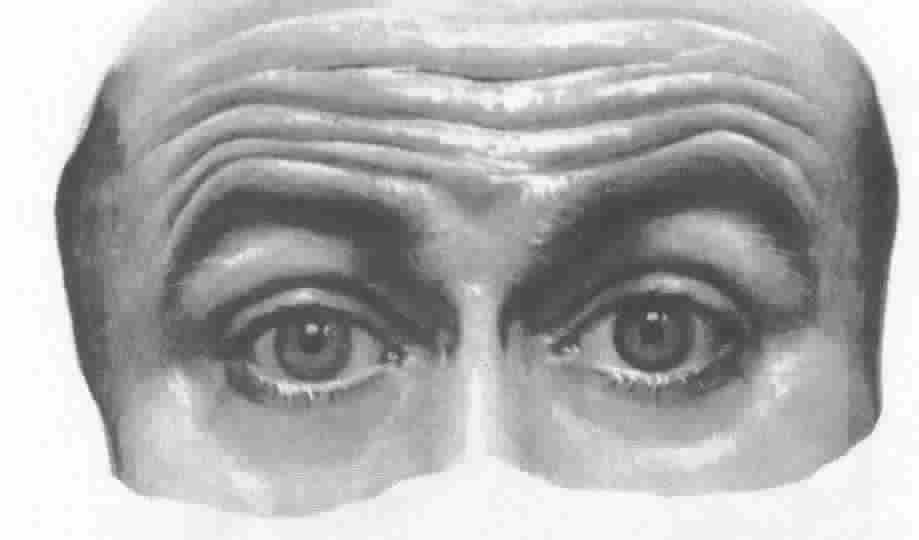EYEBROW-RAISE

He raised his eyebrows as if raising them was an effort, a trick he was out of practice on. It furrowed his whole forehead and when it smoothed out it was full of white lines that turned reddish as I watched them. --Philip Marlowe, describing Missing Persons Bureau captain Gregory (The Big Sleep, 1939:204)
. 1. To lift the arch of short hairs
above the eye, as in uncertainty, disbelief, surprise, or exasperation.
2. To elevate the eyebrow by contracting the occipitofrontalis
muscle.
Usage I: Raising the eyebrows adds intensity to facial expressions. Brow-raising can strengthen a dominant stare, exaggerate a submissive pout, or boost the energy of a smile. The involved muscle (occipitofrontalis) elevates the eyebrows to form prominent, horizontal furrows in the forehead, making almost any gesture look and feel stronger.
Usage II: In tandem with head-tilt-back, raising one or both
eyebrows suggests a supercilious air of disdain, haughtiness, or pride.
(N.B.: "Supercilious" comes from the Latin
word for "eyebrow," supercilium.) We may unconsciously lift our
eyebrows as we give orders, argue important speaking points, and make
demands.
Anatomy. Our face
evolved as a signboard to display emotions welling from the mammalian
brain. Facial messages are controlled by the facial nerve
(cranial VII). Its nucleus has both an upper and a lower component; the
former lifts and depresses our eyebrows. When we feel happy, e.g., our limbic
brain stimulates cranial VII, which innervates the forehead muscles
to raise our brows.
Media. 1. "[Phil] Donahue has a characteristic way of raising his eyebrows which draws attention to his eyes which are directed to the [TV] viewers" (Raffler-Engel 1984:12). 2. To convey authority and show strong emotion, televangelists raise their eyebrows and project their foreheads' horizontal lines onto the video screen for added dramatic effect.
RESEARCH REPORTS: 1. Eyebrow-raise is a threat sign in baboons, mandrills, and cebus monkeys (Andrew 1965; van Hooff 1967). 2. The eyebrow-flash of recognition is a worldwide friendly greeting (Eibl-Eibesfeldt 1989; Morris 1994). 3. One eyebrow raised (as in the eyebrow cock) is a widespread sign of scepticism (Morris 1994).
Neuro-notes I. Brow-raising is mediated by the top part of cranial VII's motor nucleus, which contains cells to innervate the contraction of muscles in the upper part of our face. The top part receives bilateral input from both sides of the cerebral neocortex, rather than unilaterally (as in the bottom part of the nucleus, which controls the muscles of the lower half of our face).
Neuro-notes II. Mirror neurons: "In the first weeks after birth [and '. . . probably subserved by the mirror [neuron] system . . .' (p. 21)] infants have been documented by experimental studies to imitate a variety of gestures, such as . . . brow motions . . ." [p. 24; source: Braten, Stein, and Colwyn Trevarthen (2007). Chapter 1: "Prologue," in Braten, Stein (Ed.), On Being Moved: From Mirror Neurons to Empathy (2007; Amsterdam: John Benjamins), pp. 21-34].
See also EYEBROW-LOWER.
YouTube Video: View amazing muscular control of eyebrow movements.Copyright 1999 - 2016 (David B.
Givens/Center for Nonverbal Studies)
Picture credit: Peck, Stephen R. (1951) Atlas of Human Anatomy for the Artist (London: Oxford University Press), p. 250.